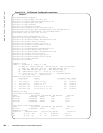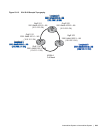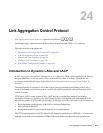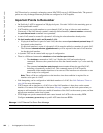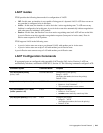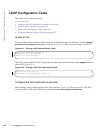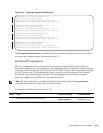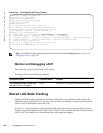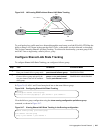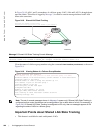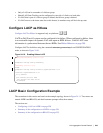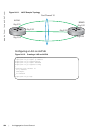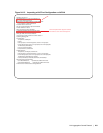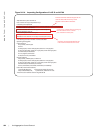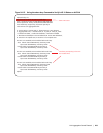
546 | Link Aggregation Control Protocol
www.dell.com | support.dell.com
Figure 24-4. Invoking the LACP Long Timeout
Monitor and Debugging LACP
The system log (syslog) records faulty LACP actions.
To debug LACP, use the following command:
Shared LAG State Tracking
Shared LAG State Tracking provides the flexibility to bring down a port channel (LAG) based on the
operational state of another LAG. At any time, only two LAGs can be a part of a group such that the fate
(status) of one LAG depends on the other LAG.
In Figure 24-5, line-rate traffic from R1 destined for R4 follows the lowest-cost route via R2, as shown.
Traffic is equally distributed between LAGs 1 and 2. If LAG 1 fails, all traffic from R1 to R4 flows across
LAG 2 only. This condition over-subscribes the link, and packets are dropped.
Note: View PDU exchanges and the timeout value using the command debug lacp. See Monitor and
Debugging LACP on page 546.
Command Syntax Command Mode Purpose
[no] debug lacp [config | events | pdu
[in | out | [interface [in | out]]]]
EXEC Debug LACP, including configuration and events.
FTOS(conf)# interface port-channel 32
FTOS(conf-if-po-32)#no shutdown
FTOS(conf-if-po-32)#switchport
FTOS(conf-if-po-32)#lacp long-timeout
FTOS(conf-if-po-32)#end
FTOS# show lacp 32
Port-channel 32 admin up, oper up, mode lacp
Actor System ID: Priority 32768, Address 0001.e800.a12b
Partner System ID: Priority 32768, Address 0001.e801.45a5
Actor Admin Key 1, Oper Key 1, Partner Oper Key 1
LACP LAG 1 is an aggregatable link
A - Active LACP, B - Passive LACP, C - Short Timeout, D - Long Timeout
E - Aggregatable Link, F - Individual Link, G - IN_SYNC, H - OUT_OF_SYNC
I - Collection enabled, J - Collection disabled, K - Distribution enabled L - Distribution disabled,
M - Partner Defaulted, N - Partner Non-defaulted, O - Receiver is in expired state,
P - Receiver is not in expired state
Port Gi 10/6 is enabled, LACP is enabled and mode is lacp
Actor Admin: State ADEHJLMP Key 1 Priority 128



